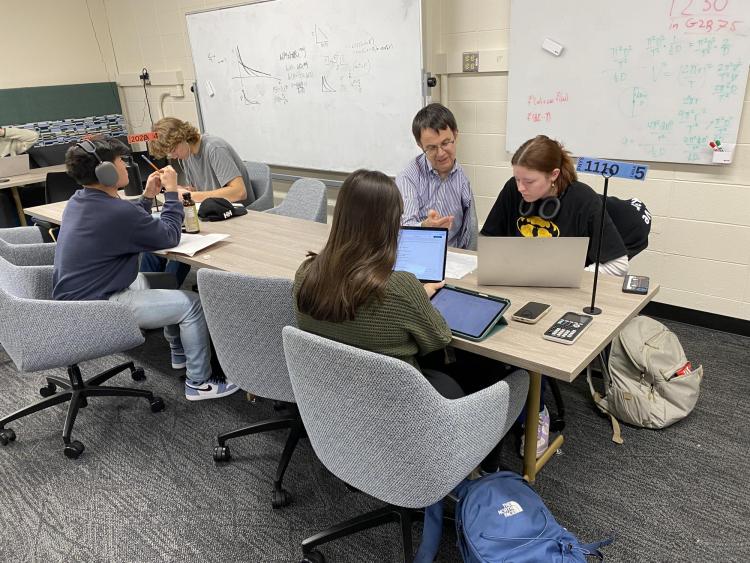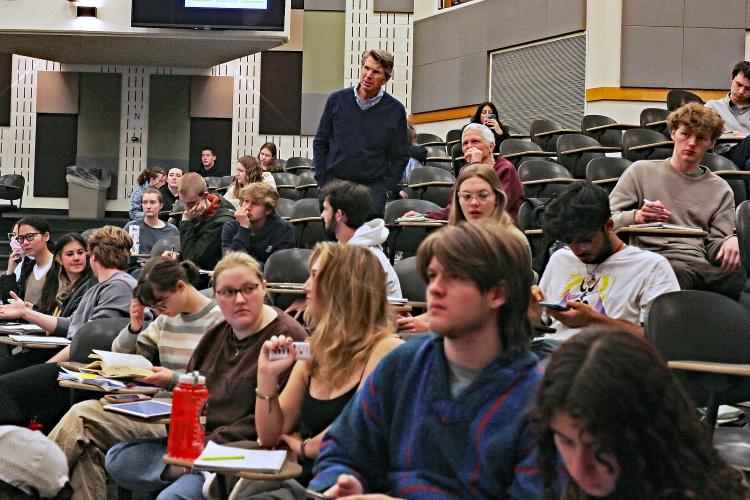A Nobel laureate walks into a first-year physics class…
General Physics for Majors course designed by CU Boulder Professors Eric Cornell and Paul Beale shows students that the furthest reaches of science are built on fundamental concepts
The Nobel laureate was not feeling happy about his minus signs.
He stood back from the blackboard—yes, an actual blackboard on which he wrote with actual chalk—and considered the calculus he’d jokingly hyped just moments before with, “This is some of that real calculus sensation. This is why you sat through that whole calculus class: for this moment.”
His team teacher, a noted scientist who this year is marking 40 years teaching physics at the University of Colorado Boulder, called from the back of the classroom, “That’s right, Eric.”

Professors Paul Beale (left) and Eric Cornell prepare for a Tuesday morning PHYS 1125 class. (Photos: Rachel Sauer)
Advanced math is not always easy with an audience watching—in this case, about 85 first-year physics, astrophysics and engineering physics students in PHYS 1125, General Physics 2 for Majors.
It’s a class for students who know they want to pursue a field of physics and are newly starting out in it. And it’s taught by a Nobel laureate.
“I harken back to freshman physics every day of my life,” explains Eric Cornell, a CU Boulder professor adjoint of physics and 2001 Nobel Prize winner in physics for his work with Bose-Einstein condensates. “I’m in a Facebook group with people I met my freshman year in physics.”
In other words, there’s absolutely no reason a Nobel laureate shouldn’t teach first-year physics.
Basic, foundational concepts
Cornell and Paul Beale, a CU Boulder professor of physics, created the course six years ago, in part to help students interested in pursuing physics to find community and support among like-minded peers. While other introductory physics courses are open to all majors, this one is specifically for physics, astrophysics and engineering physics majors. Steven Pollock, a professor of physics, and Yuan Shi, an assistant professor of physics, in the fall taught the first half of the course, PHYS 1115, which was created by Professors Chuck Rogers and Shijie Zhong.
“We start from ground zero,” Beale says. “Most (of the students) have had some physics in high school, most have seen these ideas before—they know that same charges repel. But even students who have had really good high school physics classes, maybe even AP classes, we say, ‘That’s great! Take our class.’
“Being with other physics majors helps them relax and get immersed in the field. Everybody in there really wants to be in there.”

Professor Eric Cornell (center, striped shirt) answers student questions in the physics help room.
A cynic might ask, however, why a Nobel laureate would be teaching a first-year class. Shouldn’t they be, you know, spending their time in the furthest, most esoteric reaches of physics? Doing the kind of science only a handful of people on the planet can understand?
“I want to push back on that idea that the basic, foundational concepts of physics don’t have considerable charm of their own,” Cornell says. “This is really fun stuff, and one of the things I like about this course is it gets into really interesting things right away.”
“It’s also a hard class,” Beale adds. “The concepts are difficult, so the challenge for us is to do everything we can to make them approachable. (The students) have got to get them right even though they’re hard, because everything else in physics builds on what they learn here.”
Cornell and Beale designed the class not only with beginning physics students in mind, but learning assistants and graduate students as well.
“In a lot of schools, grad students—who might be just one year past undergrad—are thrown in the classroom and told, ‘Here, go teach,’” Cornell says. In this course, however, graduate students assist with weekly tutorials but meet with Beale and Colin West, an associate teaching professor of physics, before each one, because the skills of teaching need to be taught. The same is true for class learning assistants, who are undergraduate students who took the course the previous year.
Cornell and Beale also spend time in the physics help room each week, which is a space where students can drop by for help with anything physics related.
“I would say that we are a very good teaching department, and not just our graduate program,” Beale says. “This is your introduction to physics, and you’re either going to like it or not, so we put a lot of effort into the first years.”
“We’re always asking, ‘How do we do better teaching?’” Cornell adds. “People like Paul and me have the advantage of people in this department who have studied teaching and have tried approaches like using clickers, using a conversational approach, using hands-on demonstrations. There are ongoing discussions about how we can be teaching better.”
Physics with a purple crayon
Sometimes, better teaching means an apology: “It’s my sorry duty to apologize for all the sins of physicists who went before me, and electrical engineers. And Ben Franklin,” Cornell said, writing “sorry!!” on the blackboard and underlining it twice. “I’m here to apologize for this thing called ‘potential.’ The whole rest of your life you’re going to be thinking about electric potential. It’s unavoidable. Your intuition will overwhelm your minus-sign errors.

Professor Paul Beale (standing, blue sweater) walks around the classroom during PHYS 1125 to help students and answer questions.
“It’s a ‘sorry, but...’ though, which is another way to say, ‘Suck it up.’”
While Cornell pivoted to voltage, “a happier, friendlier term (than electric potential),” Beale walked slowly among the rows of seats, stopping to sit by students who had questions and prompt them toward their response on class-wide clicker questions.
Pranay Raj Poosa, a freshman majoring in astrophysics who hopes to study black holes and neutron stars, cites Cornell’s and Beale’s enthusiasm for physics and their personal, conversational approach to teaching as two of the reasons he likes the class: “The fun they generate makes my understanding crystal clear,” he said. “The first day of class, (Cornell) made a joke about himself, which I personally felt was clap-worthy.”
Poosa added that he was in “utter disbelief” when his advisor mentioned a Nobel laureate would be teaching the class.
For Min Wang, a sophomore majoring in physics and interested in theoretical neuroscience and writing science fiction, Cornell and Beale have shown her that “great minds are not the ones who are walking in front of others all the time. They always slow down and let the young generation be on their shoulders.
“Even though what Professor Cornell taught us is just a tiny piece of knowledge in his mind, he shows amazing patience to every student and shows us how profound even a little, tiny bit in physics can be. And since I have time conflicts with all the office hours, Professor Beale gives me a special office hour time according to my school schedule. It is after class and work time on Friday! They make me feel welcome in the world of physics.”
Wang noted that while learning physics is not without its pains, she doesn’t feel alone in tackling them because she is part of a “lovely and supportive physics community created by the professors.”
Which is good, because it was time to do “a very modest amount of algebra, the kind you could do with a purple crayon if you’ve got one,” Cornell said, explaining how they could figure capacitance between two metal plates and then telling the students, “I’m going to show you something which I think is very neat. It’s kind of an advanced idea, giving you a taste of physics to come.”
The key thing to remember? “The whole idea of physics is zooming all the way into what does matter and ignoring what doesn’t.”
Did you enjoy this article? Subcribe to our newsletter. Passionate about physics? Show your support.

